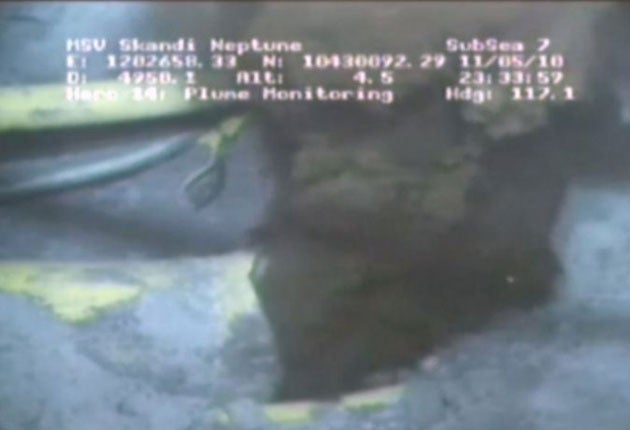Energy giant BP was preparing today to once again try and staunch the unchecked flow of oil from a ruptured well that threatens an environmental disaster in the Gulf of Mexico.
BP, operator of the well off Louisiana's coast, said it hoped to have a small containment dome in place by late today, its latest attempt to plug the roughly 5,000 barrels a day of gushing crude.
It is also fighting to salvage its soiled reputation. London-based BP, Transocean and Halliburton are all in the hot seat over their responsibility in an April 20 rig explosion that killed 11 workers and triggered what could be the most devastating US oil spill ever.
Scientists say coastal wetlands threatened by the spill, which provide critical habitat for bird life and serve as rich nurseries for the region's valuable shrimp and oyster stocks, are already dwindling from erosion and development.
Oil pollution would accelerate the process by killing the vegetation that holds the marshes together.
"If we allow that oil to come in and touch our marshlands, that'll shut us down for about five to six years," said Rodney Dufrene, 23, a new shrimp boat owner from the hamlet of Cut Off, north of Port Fourchon.
Investors have knocked about $30bn off BP's share value and the Wall Street Journal reported yesterday BP had decided to finish work on Deepwater Horizon despite tests suggesting combustible gas had seeped into the well.
And a House of Representatives panel said it had uncovered significant problems with a safety control mechanism on BP's well that could have contributed to the accident.
Representative Bart Stupak, a Democrat, said his panel's investigation showed the Deepwater Horizon rig's underwater blowout preventer leaked and was not powerful enough to cut off the oil flow before the rig blew up.
The New York Times reported today that BP had drafted plans to work on or around the blowout preventer to seal the well. One option would be a "junk shot" that would clog the blowout preventer with materials including shredded tires and golf balls, the Times reported.
Democratic Representative Henry Waxman, quoting from a BP document describing its view of events, said the well failed a pressure test in the hours before the blast.
Panel investigators spoke with officials of the company that manufactured the blowout preventer and reviewed company documents, finding the device on the rig was modified, making it hard to operate after the accident.
Today, a massive operation was gearing up. Federal authorities said more than 510 vessels were responding to assist in containment and cleanup efforts in addition to dozens of aircraft and remotely operated vehicles.
Fourteen staging areas have been set up and approximately 500,000 metres of boom - plastic barriers strung along the coast - have been deployed to contain the spill and another 500,000 metres remain available.
Cleanup crews found oil washing ashore at Whiskey Island in Louisiana's Terrebonne Bay, west of the Mississippi Delta. Crude has also been found at the Chandeleur Islands and Port Eads in the state, as well as on Dauphin Island in Alabama.
Efforts also continue to focus on cutting off the flow, which threatens regional economic mainstays including fishing and tourism as well as wildlife throughout the Gulf region.
The attempt to maneuver the "top hat" containment dome over the leak was already underway. BP engineers lowered it to the seabed and are hoping to start capturing oil by late today.
BP Chief Operating Officer Doug Suttles said the company is studying whether to try just positioning the top hat over the leak or inserting a tube directly into the existing equipment. Both methods would involve siphoning the crude to a tanker.
The company is not guaranteeing success, citing the difficulties of working almost a mile under the ocean surface. A buildup of slushy gas hydrates stymied its first attempt at covering the rupture with a huge metal dome. BP is also drilling a relief well, which could take 80 more days.
At Port Fourchon, the tip of southeastern Louisiana's La Fourche Parish and the main supply harbor for the Gulf's deepwater oil and gas industry, gooyey, rust-colored globules were found washed up on a beach around sunset on Wednesday.
A sample of the blobs, recovered by a Reuters reporter, was collected by harbor police for testing to determine whether the substance came from the oil spill. Officers who took the sample refused to speculate on its origins.
Crews have found oil washing ashore at Whiskey Island in Louisiana's Terrebonne Bay, west of the Mississippi Delta. Crude has also been found at the Chandeleur Islands and Port Eads in the state, as well as on Alabama's Dauphin Island.
There were small protests against BP in several US cities. In Los Angeles, about 50 people protested at a busy street corner near a BP gas station. They waved signs that said "Spill Baby Spill" and "BP is not green, its deadly."
In San Francisco, about 30 people marched in a circle and chanted slogans while in Chicago two dozen protesters passed out flyers at a downtown street corner near BP's Chicago offices, chanting "seize BP, make them pay".
Nearly 100 lawsuits have already been filed across the Gulf region and the disaster, which lawyers see becoming one of the biggest class actions in U.S. history, involves billions of dollars in potential liabilities.
So far, 87 sea turtles, 18 birds and six dolphins have been found dead, officials said. Scientists are testing to determine if the oil spill killed them, or if they died of other causes.
Subscribe to Independent Premium to bookmark this article
Want to bookmark your favourite articles and stories to read or reference later? Start your Independent Premium subscription today.


Join our commenting forum
Join thought-provoking conversations, follow other Independent readers and see their replies